IN THIS ISSUE FEBRUARY 2013
Creating Worthwhile Dealer Events 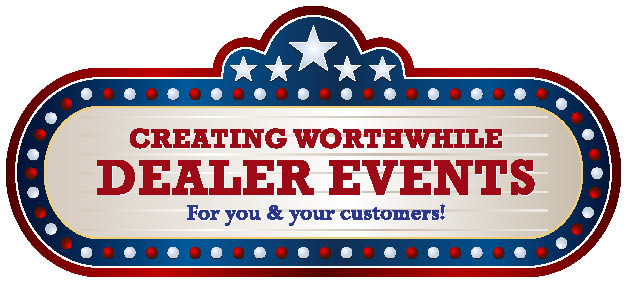
Dealer-run planter clinics help foster customer relationships and get the check writers in the door.
Hosting a planter clinic takes a certain amount of planning and organization. But if you put the time and energy needed into the event, it can be beneficial to both you and your customers. Clinics also provide an opportunity to build new relationships and strengthen existing ones.
“Be certain to keep the clinic brand-neutral. We have brought many competitive planter owners to our events, built relationships with them, sold them our services, accessories, attachments, etc., then transitioned them to our brand of planter when the buyer’s cycle afforded the opportunity,” says Don Hoover, owner of Binkley & Hurst in Lititz, Pa.
First Things First
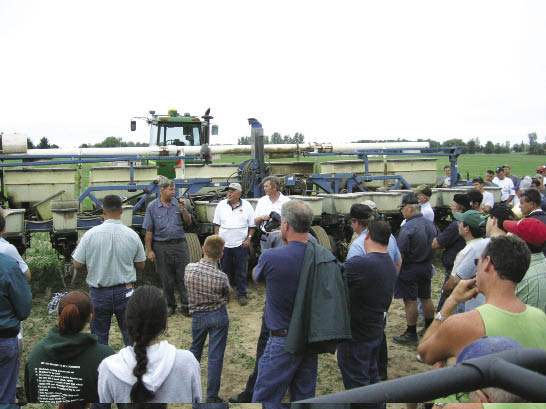
Donn Branton of LeRoy, N.Y., takes a group of farmers on a walk-around of a planter. Walk-arounds give customers the opportunity get a first-hand look at aspects of the planter that were discussed during PowerPoint presentations earlier in the day. Photo courtesy of Cornell Cooperative Extension Vegetable Program (CVP)
Figuring out who you want to attend the clinic is a must before you move ahead with any other planning. “One of the most important things when you are doing a specific clinic, like a planter clinic, is preparing a specific customer list of the people you want there. We have found that a mix of current owners and prospective owners is a great mix to have,” explains David Davis, store manager for Titan Machinery’s Pella, Iowa, location.
“The owners will affirm what the company or the store people are saying about the planters. That’s only good if you have a good product, and we do. We find it to be an effective way for the prospective guys to hear first hand from people they know. It’s just a good mix,” Davis says.
It’s also important to figure out how many people you can comfortably accommodate. Davis says the Pella store can handle 40-50 people when they have a group made up of both current and potential customers. Your number, however, will depend on your available space and personnel.
Once you know whom you’re going to target, you can start working on the content and focus of the clinic.
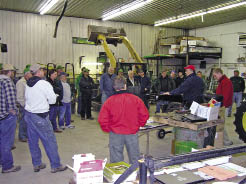
Don Hoover, owner of Binkley & Hurst, gives a hands-on presentation in the shop during a planter clinic. Hoover recommends keeping the clinic brand-neutral. “We have brought many competitive planter owners to our events, built relationships with them, sold them our services, accessories, attachments, etc., then transitioned them to our brand of planter when the buyer’s cycle afforded the opportunity,” he says. Photo courtesy of Binkley & Hurst
“After doing clinics a few times, we found that making sure the presenters know what kind of customer base is attending, means we can cover various models very well,” Davis says. “The worst thing you can do is get your current owners in and then sell them on features. They already know why they bought what they did. So it’s really important, as you’re planning your clinic, to define your purpose and make sure you know what you’re doing and who you’re speaking with.”
Davis explains that the two groups can be successfully mingled because current owners appreciate refreshers on the features and benefits. And for those who haven’t bought yet, it offers them a chance to learn about the maintenance too because “that’s an important aspect for them,” he says.
“You get the right presenters who understand that, and it tends to be a very successful clinic,” says Davis.
Pat McCrabb, operations officer at Precision Equipment in Muscatine, Iowa, agrees. He says determining what results you expect from the clinic needs to be the first part of planning. “These clinics need to be very focused and driven toward a particular outcome, or it ends up having too broad of an agenda and either you end up giving information that was too basic for some and the rest are lost and it ends up being a distraction,” he says.
McCrabb adds: “When we have maintained this focused approach we have found it to ultimately drive sales especially toward all the new technology on planters. Customers have told us they want to be invited to clinics that are truly going to train or inform them on products and services that will improve their operation.”
Dealer Takeaways
• Determine who your target audience will be first, and then design a focused presentation around that audience’s needs.
• Don’t rely solely on mailed out invitations. Have your staff call those you’ve invited personally to remind them about the event.
• Only give attendees useful handouts such as laminated worksheets they can keep in their tractor as on the spot reference guides.
In terms of timing, plan the clinic to last about three hours. Davis says Titan Machinery starts its clinics at 9 a.m. and ends them at noon by serving lunch to the group. Eric Stith, aftermarket manager for Mid-State Equipment in Janesville, Wis., says they also plan the clinic around lunch time — starting either right before or after noon so lunch can be tied in.
Marketing Does Matter
Flyers and posters advertising the event around the dealership — from the showroom to the service counter — are good ways to inform customers of what is planned. Two to three weeks before the clinic, you should be sending out personal invitations with the details to your target customers.
“The big thing we found to be important is to follow up with the customers via email or phone a few days before the event as people will sometimes forget the date and time and will miss it,” says Stith.
Titan Machinery’s Davis agrees. “You should never make the assumption that because you send out an invitation everybody is going to come,” he says. “We get on the phone two days before and follow up. We really try to remind customers because everyone is so busy. We remind them about the clinic and try to get a commitment from them.”
Davis says the follow up call helps on a variety of levels. It helps with figuring out the presentation itself, as well as details needed for preparing food and setup. Most importantly, though, it helps with turnout.
“We have found that if we don’t do a follow up, our turnout isn’t nearly as good as when we actually get on the phone and re-invite them,” Davis says.
Marketing measures shouldn’t end before the event, though. At Mid-State, they make sure to gather customer information during the event for future marketing efforts. “We also get customers to register for giveaways in an effort to collect emails and other information from them for future reference,” Stith says.
Developing the Program
When it comes time for the clinic, variety is important. That goes for both the presenters themselves and the presentation materials. Davis stresses that it’s essential to have some manufacturer representatives present as well as dealership personnel.
“We divide up duties because it’s important to have store personnel involved in the event. On one hand, it’s great for the manufacturer to come in, but when they leave you want the customers looking toward your store and people to provide everything that you talked about,” Davis says. “We have a good mix of presentation and face time with the manufacturer and personnel from the dealership.”
The benefit of enlisting manufacturer representatives is they will provide actual planter cut-a-ways that demonstrate what to look for, what to replace and what not replacing something can do to affect stands, James Braxton, general manager of Wade Inc. in Indianola, Miss., explains.
On the dealer side, enlist some of your technicians to present. “We like to have the experts — our technicians — present the information to the customers. With some coaching and assistance, several of them have become very good at this,” Stith says.
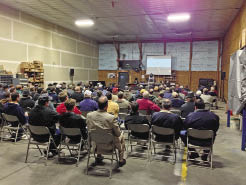
PowerPoint presentations provide a clear and precise demonstration that allows more customers to participate and still get a high value out of the clinic. Photo courtesy of Binkley & Hurst
Hoover of Binkley & Hurst also advises dealers use a combination of dealership personnel and industry professionals, such as vendor specialists. “Sometimes dealership personnel need to ‘localize’ the information being presented because territory personnel may make equipment recommendations that are not applicable in a specific geography, soil types, etc.,” he says.
When it comes to the presentation itself, keep in mind that everyone learns differently and at different speeds. Make sure you’ve got handouts and some hands-on aspects to the clinic, says Jerry Pankratz, seeding specialist and field service technician for PrairieLand Partners Inc. in Hutchinson, Kan. PrairieLand Partners incorporate very specific training on the details on seeding equipment, mapping, row control, variable rate seed and fertilizer.
Pankratz also advises to keep things moving fairly quickly. While there is a lot of good information to get through, your customers’ attention will start to fade if each section starts to get too long.
“Bottom line is to move through the information promptly, alternate between video, PowerPoint, hands on, and when you’re through the material, stop talking,” Pankratz says. “I will spend 40 hours preparing for 45 minutes of material. There will be a manager to open the meeting, and usually a member of the sales staff will discuss where technology is headed. Then I will cover the planter information. It helps to occasionally pick on your customers by name, too.
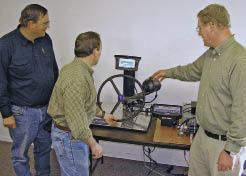
Keep in mind that everyone learns differently and at different paces. Alternating between talks, hands-on presentations and handouts ensures everyone will get a good grasp on the content. Here, a Binkley & Hurst technician demonstrates the guidance system for the planter to two customers. Photo courtesy of Binkley & Hurst
“Again, lots of hands-on parts and handouts are critical to presenting the information in as many ways as possible — we all learn differently and at a different pace,” Pankratz says.
Make Techs, Handouts Available
Titan’s Davis recommends having technicians present for the entire clinic. This way, customers have an opportunity to see who they are and meet them before heading out to see the equipment up close and personal after the presentations from the manufacturer. “It’s the customers’ best opportunity to visit with the technicians, and it’s a nice way to transition to the store level. Our clinics then end pretty informally, mainly customers mingle with the guys that are putting these machines together and fixing them. The guys that know the equipment inside and out. It brings the focus back to the store,” Davis says.
Finally, give the attendees something they can take with them — something they can reference when they hook up the planter. “Give them something that relates to how the planter is going to practically work for them, they like that,” Davis says. “They’re not real interested in a copy of the PowerPoint or that kind of stuff.”
Davis says his Titan store hands out laminated worksheets, which have been well received by customers. “Now they can put them in their tractors and it doesn’t get all crumpled up. Giving them useful and informative handouts is a real plus,” he says.
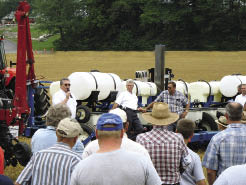
“Make the clinics comprehensive, covering the iron involved on the planter as well as conditions and realities around the planting process,” advises Don Hoover, owner of Binkley & Hurst. Photo courtesy of Binkley & Hurst
Offering some sort of service deal along with the planter clinic can be beneficial as well. This will help encourage owners and operators to return for service business and gives you the opportunity to keep growing the relationship. “Generally, a token discount on planter parts is offered to attendees of our clinics. If we are doing an offsite clinic, (young farmer group, soil conservation district, seed company field day or such) we will sometimes give gift cards to be redeemed at our parts counter in order to bring new relationships in the door,” Hoover says.
Follow-up calls after the clinic help keep that relationship going. Davis says they have the service department call existing owners and the sales staff calls the attendees who aren’t yet customers. That relationship building is what ties the entire event together and keeps the dealership in the front of its customers, or potential customers, and that’s the real benefit to the dealer.
“For one thing, it gets people in your store who may not spend any time there. Even for some of our existing customers, who often send their hired people to the dealership, it helps get the check writers into the store. They can see your facility and meet your staff.
“It helps to build that longer-term relationship with the people making the buying decisions. That’s a real plus,” Davis says.






